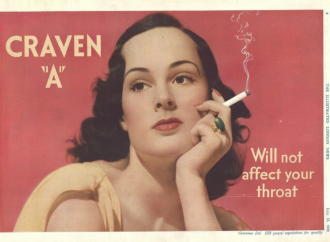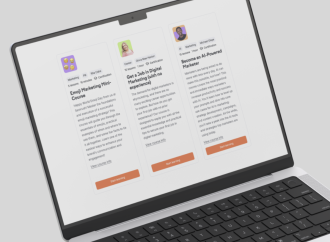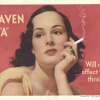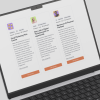Boost Your SaaS Success: Best Practices for Marketing and Branding The SaaS industry has grown immensely, with businesses now using web-based tools for everything from managing projects to customer relationship management. However, standing out in such a crowded market is not just about having the best features—it’s about building trust, showing value, and creating meaningful

Boost Your SaaS Success: Best Practices for Marketing and Branding
The SaaS industry has grown immensely, with businesses now using web-based tools for everything from managing projects to customer relationship management. However, standing out in such a crowded market is not just about having the best features—it’s about building trust, showing value, and creating meaningful connections with users. To do this effectively, marketing and branding need to go hand in hand. Whether you’re a new startup or an established company looking to scale, aligning your brand identity with user-focused marketing can make a huge difference.
Build a Memorable Brand Identity
Your brand identity goes beyond just a logo—it’s your mission, values, and the promise you make to your customers. A strong brand resonates with users on a deeper level, helping them choose you over the competition. In the SaaS world, where the product is often seen as just a tool to solve a problem, a powerful brand persona can build loyalty. Look at major tech companies—they don’t just sell a product, they offer a lifestyle or a vision.
Focus on what sets you apart: Show that you care about more than just making sales; show that your brand reflects your customers’ values and goals.
Highlight Your Unique Selling Points
SaaS products can seem very similar at first—everyone claims to improve efficiency, save time, or streamline processes. To stand out, you need to explain what makes you different. Maybe your software integrates better with popular tools, or your interface is incredibly simple. Or maybe your pricing is more transparent. Find the features that matter most to your users and highlight them in your marketing. Show your potential customers exactly what they can’t get anywhere else.
Avoid generic language: Instead of relying on vague terms like “fast” or “secure,” use specific details that show what makes your product unique.
Focus on benefits: Highlight what your product actually does for users, not just its features.
Develop a Content Strategy Focused on Users
Content marketing is a key tool for SaaS businesses. Go beyond blog posts and create whitepapers, tutorials, case studies, and interactive demos that show how your software solves real-world problems. Offer content for every stage of the customer journey—from educational content for awareness to success stories for final decision-making. Over time, you’ll build a library of resources that positions your brand as a thought leader and a trusted partner.
Align with the funnel: Tailor your content to different stages of the user journey, from awareness to consideration to decision-making.
Tell a story: Use real-life data and user stories to personalize your content and connect on a deeper level.
Show Social Proof and Build Community
Trust is crucial when choosing a SaaS product, especially in a crowded market. Social proof—like testimonials, reviews, and user-generated content—plays a big role in influencing decisions. Showcasing big-name clients or case studies can also demonstrate your software’s scalability. In addition, creating a community around your product (like a forum or a LinkedIn group) can help users share tips, ask questions, and feel part of a bigger mission. This sense of community helps reduce churn and keeps your brand top of mind, especially when it’s time for renewals.
Show trust: Display client logos, testimonials, or certifications to build credibility.
Foster engagement: Encourage a community-driven approach where users can support each other and feel connected to your brand.
Streamline Free Trials and Onboarding
Most SaaS marketing revolves around free trials or freemium models, giving users a chance to experience your product firsthand. Make sure the sign-up process is smooth and easy, with minimal fields and clear instructions. Once users are in, an effective onboarding process—like guided tours or helpful email tips—can ensure they see the value of your software right away. A smooth onboarding process is key to turning trial users into long-term customers and can significantly boost retention.
Make it easy to get started: Ensure users can see benefits immediately, without going through complicated setups.
Provide helpful tutorials: Use different formats (videos, text, interactive guides) to cater to different user preferences.
Use Email Marketing to Keep Users Engaged
Retention is vital for SaaS businesses, as recurring revenue is often more important than initial sign-ups. Email marketing remains one of the most effective ways to nurture this relationship. Segment your email list based on user behavior—who’s using advanced features versus those who are inactive—and send personalized tips, updates, and check-ins. Don’t just announce new features—offer suggestions on how to integrate them into users’ workflows to get better results.
Target specific groups: Tailor your messages to different user types to increase engagement.
Show real value: Highlight practical examples of how new features can improve users’ day-to-day tasks.
Take Advantage of SEO and Paid Ads
Organic search is a great way to bring in long-term, cost-effective leads. Identify relevant keywords that match user intent—like “best CRM for small businesses” or “simple project management software”—and create content that targets these terms. At the same time, paid ads can help you appear at the top of search results for high-value keywords. With the right landing pages, you can guide potential customers to sign up, take a demo, or start a free trial.
Focus on SEO: Use long-tail keywords to drive traffic from relevant search queries.
Ensure consistency: Make sure your ad copy, website content, and calls to action align with each other to create a seamless experience for users.
Keep Your Brand Consistent Everywhere
Your SaaS product is likely to appear on various platforms—social media, review sites, and marketplaces. Keeping your brand consistent across all these platforms helps potential customers recognize you immediately. Whether it’s using the same color scheme on Twitter or maintaining the same messaging on LinkedIn, consistency builds trust and familiarity. Any inconsistencies can cause confusion and reduce user confidence.
Consistency is key: Keep your visuals and messaging the same across all platforms.
Have a style guide: A clear guide for colors, fonts, and voice ensures consistency in all content creation.
Track Key Metrics and Make Adjustments
Success in SaaS relies on understanding key metrics like customer acquisition cost (CAC), lifetime value (LTV), churn rate, and trial-to-paid conversion rate. Monitoring these numbers gives you valuable insights into user behavior and helps you identify areas for improvement. For example, if you notice a spike in churn after three months, you might need to improve onboarding or feature adoption. Use tools like Google Analytics or Mixpanel to get detailed insights and continuously refine your marketing strategy based on real data.
Analyze metrics: Use data to pinpoint areas for growth and improvement.
Iterate and test: Regularly test different strategies and make adjustments to optimize your campaigns.
Engage with Your Users on a Personal Level
Despite all the automation and data dashboards, always remember you’re dealing with real people who have unique challenges and needs. Listen to user feedback through reviews, social media, and customer support channels. Address common concerns and stay open to ideas for new features. By engaging with your audience personally—through direct emails or quick video calls—you can build stronger relationships and turn users into brand advocates who will recommend your product to others.
Listen carefully: Genuine engagement with users builds stronger partnerships.
Add a personal touch: Combining automation with personal communication helps strengthen user loyalty.
The Future of SaaS Marketing
Looking forward, SaaS marketing will likely focus more on personalization, leveraging AI-driven insights to create tailored experiences for each user. With subscription fatigue becoming more common, companies may experiment with more flexible pricing structures to attract new customers. New marketing techniques like interactive demos, virtual product tours, and influencer partnerships could become standard as digital-savvy consumers demand more engaging experiences. At the heart of it all, staying true to your users’ needs and staying authentic will be crucial to success.
Personalization is key: Advanced analytics and AI will help create marketing strategies tailored to individual preferences.
Build authentic relationships: Long-term user loyalty comes from solving real problems and showing genuine empathy.
Building a successful SaaS marketing and branding strategy goes beyond just a catchy logo or a single marketing channel. By developing a memorable brand identity, highlighting what sets you apart, creating user-focused content, and maintaining consistency across all platforms, you can earn trust and loyalty. Efforts like showcasing social proof, guiding users through onboarding, and tracking performance metrics will further enhance user engagement. As technology continues to evolve, staying human-centered and adapting to trends will ensure your SaaS product continues to resonate with users and solve their problems effectively.

















Leave a Comment
Your email address will not be published. Required fields are marked with *